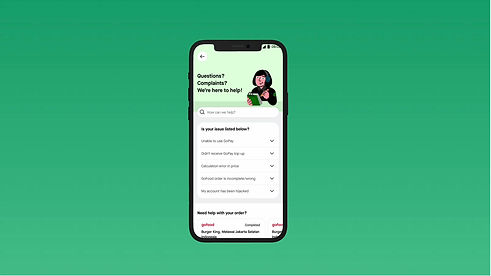Help & support -Service design
| 2023-24
Re-establishing vision and streamlining teams for focusing on end -user experience
Story Begins ...
Gojek's initial focus on transitioning from a call center to an app left the Help Center lagging behind in user-centricity. Urgent needs and ad-hoc solutions led to an unstructured knowledge base and a disconnect between user expectations and support experience.
Users were unhappy, Help & support team was also unhappy
Lack of Empathy:
Resolutions didn't address the emotional impact of issues.
Inefficient processes:
Lengthy and tedious resolution methods caused frustration.
Mismatched Severity:
Resolution methods weren't tailored to the issue's seriousness.

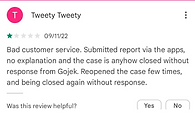


Internally, the team struggled with:
-
Interdependencies:
Unclear ownership of issues led to inefficiencies. -
Undefined Roles:
Lack of clarity on team member responsibilities hampered smooth operation. -
Reactive Approach:
High-urgency issues were addressed with temporary fixes, neglecting long-term solutions.

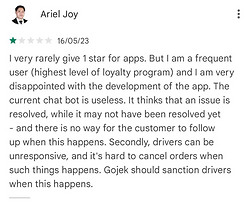
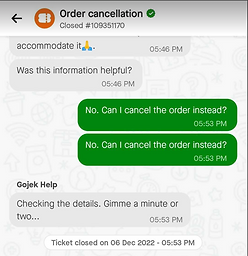
To get to the route of the problem...
I gathered information to understand the service and its functioning.
-
I initiated the project by conducting comprehensive desk research, going through existing artefacts such as research documents, organisational structures, and business requirement documents.
-
To gain a profound understanding, I conducted servicer safari. I simulated an issue, actively experiencing the process firsthand. Subsequently, I meticulously tracked and shadowed the resolution process alongside agents in their work environment.
-
Additionally, I observed agents addressing analogous issues encountered by users, immersing myself in user interactions through recorded phone calls and chat logs.
-
Collaborated with research identified & collated list of issues that were crucial.
-
Further understood why some of the issues have not been addressed Or are taking time to be responded or resolved in one on one discussions with stakeholders.
-
Wrote a one- pager documenting challenges and pending items. Shared these insights with stakeholders



Post deep diving and understanding the working & history of the product, I proposed the following solutions
Proposed Solution
We adopted a multifaceted approach to revamp the Help experience :
-
Content Strategy:
Content needed to be re-organized for better find-ability. Information was categorized and language simplified for user comprehension

-
Defining roles & responsibilities:
In order to define roles and responsibilities within the team were clearly and fostered collaboration and improved issue resolution efficiency. We conducted workshops -
Workshop 1:
2h-Workshop | 10 PIC from each team | 3 facilitators



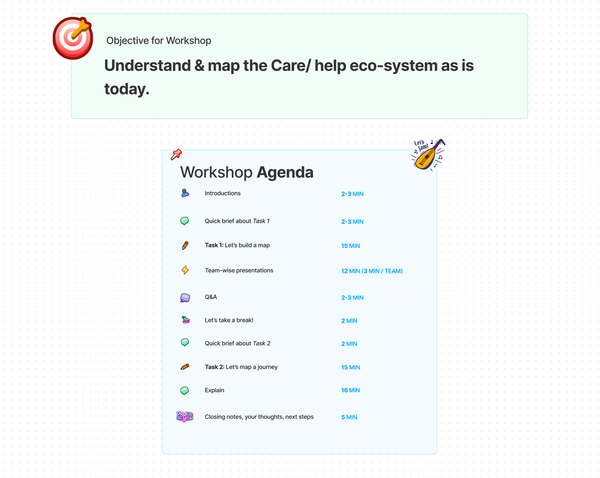
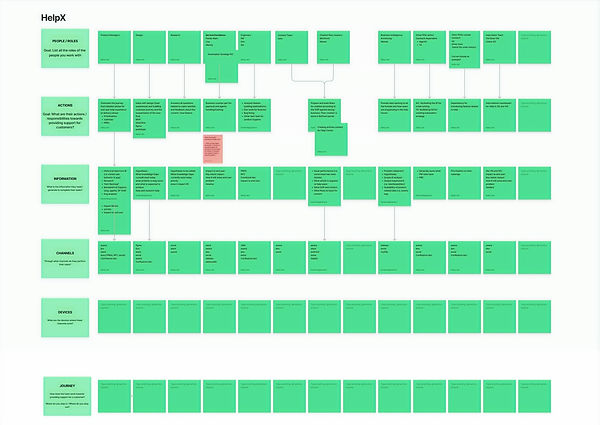

🖇️ Outputs:
-
Creating a rough map of the current of the ecosystem
-
Identify the various Users (Who), Processes (How), Actions (What), Roadblocks (Why can’t we) and Artifacts (Produced / Used), Channels (Means) and Information that moves a ticket from point A to point B.
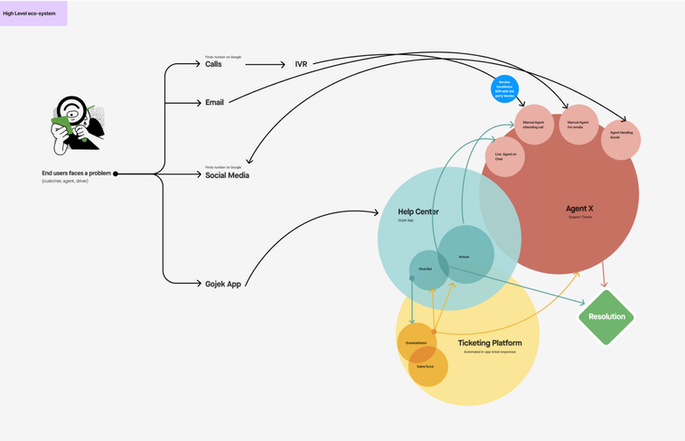
💡 Outcome of the mapping:
-
As a product team, discovering the list of teams and stakeholders provided clarity, shedding light on their functions and processes. This also highlighted the need for more efficient collaboration within our team.
-
This activity played a crucial role in communicating user pain points and identifying gaps to the business.
-
It facilitated a deeper understanding of areas within our team where knowledge was previously lacking.
Key Actionable/ take-ways :
-
Design team to partner up with Service excellence team in order to map & ideate journeys. Also provide assistance guidance with help of UX writing.
-
Ticketing platform & helpX team to work as one unit instead of separate teams.
-
The number of tools/channels of communication for the internal teams needs to be streamlined to ensure effective communication.
-
There is a need to bring more transparency between the initiatives and progress of different teams
-
User-Centric Approach (defining end-user)
Aligning the team around a shared understanding of the end user through workshops. This helped us design content, processes, and communication strategies that catered to specific user needs and expectations.
Workshop 2:
To address effective communication with-in the team & bring focus to the end-user needs & pain point.



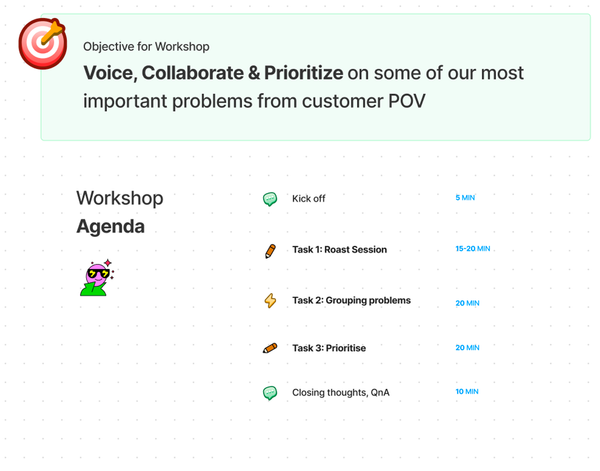
To set the stage, we mapped the journey of help experience and ask stakeholders to speak freely and add comments on journey. (What is not working? What could be better? ) no filters!


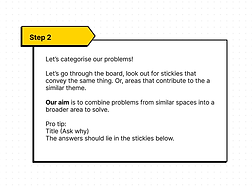


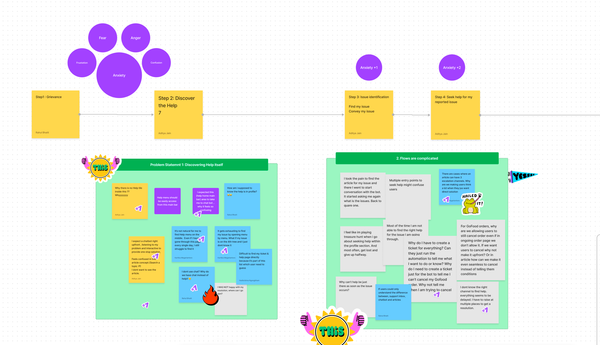
Workshop 3:
Continuing from workshop 2, we re-frame problems, Opportunities (HMW) and Hypotheses.



With the help of existing data and research, we have prioritised problem spaces and identified opportunity areas using the "how might we" approach. Further prioritise

🖇️ Outputs
List of problems and opportunities that can provide momentum for the next two years.
💡 Outcome :
-
Aligned collaboratively on initiatives to be selected for the upcoming year.
-
Ensure that goals and initiatives are aligned with realistic timelines and any dependencies are identified.
-
Align on vision & current workings
Aligning the team around a shared understanding of the end user through workshops. This helped us design content, processes, and communication strategies that catered to specific user needs and expectations.
Creating Service Blueprint
-
Prioritising Problem Spaces:
-
Collaboratively working with the research team to identify and prioritise key problem areas.
-
-
Rough Service Blueprint for Post-Order Issue:
-
Engaging in collaborative efforts to create a rough service blueprint, aligning on the expected journey and vision for addressing post-order issues.
-
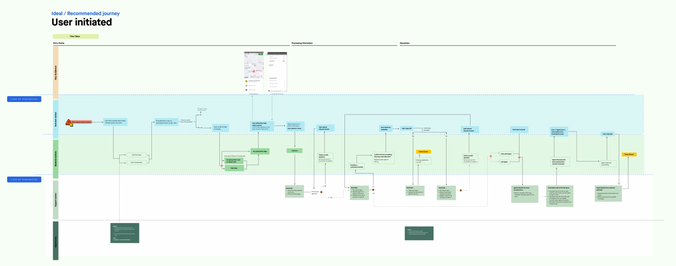
🖇️ Outputs
-
Mapped the current journey & the ideal journey
-
Identified how the issues were inter-linked
💡 Outcome :
-
We have a reference visually to see how the service is working and helps focus on the what the ideal experience should be.
Next steps:
In addressing the next phase, our attention is directed towards two specific challenges:
As a member of the User Facing Experience team, my primary focus now involves delving deeper into initiatives related to end-users. The improvement of the Help Home experience stands out as a key priority in this pursuit.

Team
-
Product Designer ( 2 member team )
-
Researcher
-
Product Managers
-
Service excellence team business
Key Skill
-
Planning & conducting workshop.
-
Stakeholder management
-
Creating vision, plans & strategy
-
Cross functional collaboration
-
Quick mocks & wire-framing concepts.
-
Communication & adaptability
As a Senior Product Designer, I've spearheaded initiatives from initial planning stages through to executing final designs, ensuring comprehensive oversight across the entire project lifecycle. This holistic approach has been instrumental in initiatives such as home redesign, where I've leveraged my expertise to address customer pain points and implement solutions effectively. Emphasising collaboration and a user-centric approach, I've driven efforts to enhance the overall user experience and foster long-term customer satisfaction
Responsibility
-
Lead, guide and mentor design team on the project.
-
Ideate and facilitate collaborative solutions.
-
Creating vision, plans & strategy
-
Create journey & service mapping
-
Quick mocks & wire-framing concepts.
-
Document and create arti-facts that can list decisions and backlog.
-
Support and continue working on initiative that are on going.
My Learnings:
In leading this design-centric project, my first venture into guiding a service design process, proved to be both challenging and immensely rewarding. Key takeaways include:
Collaborative Team Efforts:
-
Recognizing the imperative for multiple teams to closely collaborate for effective resolution.
-
Overcoming challenges arising from team members' initial lack of awareness regarding existing dependencies.
Empathetic Leadership:
-
Cultivating empathy towards team members' pain points and establishing a comfortable environment that encourages vulnerability, aiming to understand the motivations and challenges unique to each individual. (A particularly challenging but crucial skill to develop given the diverse backgrounds of team members)
Patience in Execution:
-
Learning the value of patience, especially as seemingly straightforward activities often required extended timelines for execution.
Focus on the Greater Goal:
-
Emphasising the importance of focusing on the bigger picture, understanding that certain changes might not yield immediate, measurable results, especially in a domain like Help where metrics may spike only during critical incidents.
Improving Help Home Experience
| 2023-24
Improving the Help Home Experience emerged as a vital initiative stemming from our service design exercise. This effort is strategically aimed at addressing both issue discovery and reducing user anxiety within the help experience.
*Password Protected. Message me on linked-in to get access
